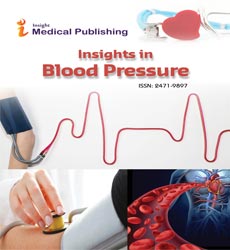Hypertension and Uric Acid in Adolescents: An Editorial
Wei Zhang
Wei Zhang *
Department of Hypertension, Ruijin Hospital, Shanghai Jiaotong University School of Medicine, Shanghai, China.
- *Corresponding Author:
- Wei Zhang
Department of Hypertension
Ruijin Hospital
Shanghai Jiaotong University School of Medicine
Shanghai, China
Received Date: October 10, 2021; Accepted Date: October 15, 2021; Published Date: October 20, 2021
Citation: Zhang W (2021) Hypertension and Uric Acid in Adolescents: An Editorial. Insights Blood Press Vol.7 No.5:4
Editorial
In adults with high Blood Pressure (BP), elevated serum Uric Acid (UA) is common; however, data from teenagers is sparse. In a nationally representative sample of Taiwan teenagers, the relationship between serum UA and blood pressure was investigated. Males, obese adolescents, and those with a UA of less than 5.5 mg/dL were more likely to have high blood pressure, regardless of age or family history of hypertension. In this investigation, serum UA levels were found to be substantially linked with blood pressure in Taiwanese teenagers.
Although serum urate has been linked to hypertension and cardiovascular illness, it is unclear if it is a causal factor. To find out, we used data from the UK Biobank, the Million Veterans Program, and a genome-wide association research to undertake Mendelian randomization analysis. Obesity and irregularities in sleeping Blood Pressure (BP) are well-known risk factors for hypertension and Cardiovascular Disease (CVDs). The study's main goal was to determine the prevalence of hypertension and a non-dipping profile in overweight/obese people.
The presence of uric acid has been linked to the development of hypertension. If Low Birth Weight (LBW) combined with CatchUp Growth (CUG) is linked to consistently elevated Serum Uric Acid Levels (SUA) level trajectories, LBW children who undergo CUG may be at a higher risk of developing hypertension later in life. As a result, this cohort study looked at longitudinal trends in SUA levels and blood pressure variations in relation to preand postnatal growth over a lengthy period of time. Uratelowering therapy should be utilised to reduce cardiovascular risk if hyperuricemia is an independent risk factor in blood pressure regulation.
It could potentially be used as a prognostic indicator for other problems. The current evidence on the association between hyperuricemia and hypertension is presented in this review. Dietary salt consumption interacts with serum uric acid to alter Blood Pressure (BP) in children and adolescents, according to our hypothesis. In this study, we looked at ambulatory blood pressure in children and adolescents in relation to hyperuricaemia, dietary sodium intake, and their interactions. Recent research suggests that high levels of serum uric acid in infancy are caused by the in-utero environment and can lead to high blood pressure in adulthood. However, uric acid levels in the blood can fluctuate over time.
The effect of serum uric acid levels in childhood on BP tracking was explored, and BP was analysed in relation to variations in serum uric acid levels in early life. These findings point to the necessity of maintaining a healthy level of serum uric acids beginning in childhood. In a high-risk group, proper monitoring and control of uric acid levels can lower the risk of future elevated blood pressure. Hyperuricemia has long been linked to an increased risk of cardiovascular disease, and arterial stiffness has been suggested as a possible mediator.
The goal of this study is to look at the links between Uric Acid (UA) in the blood and urine and arterial stiffness in a Chinese cohort. Elevated serum uric acid is a predictor of initial hypertension and blood pressure development, according to data from numerous large, longitudinal cardiovascular disease investigations. More than 90% of children with essential hypertension have blood uric acid levels above 5.5 mg/dL, according to a paediatric study. Laboratory investigations have offered compelling mechanistic evidence to explain the clinical observations within the same time span.
Open Access Journals
- Aquaculture & Veterinary Science
- Chemistry & Chemical Sciences
- Clinical Sciences
- Engineering
- General Science
- Genetics & Molecular Biology
- Health Care & Nursing
- Immunology & Microbiology
- Materials Science
- Mathematics & Physics
- Medical Sciences
- Neurology & Psychiatry
- Oncology & Cancer Science
- Pharmaceutical Sciences
